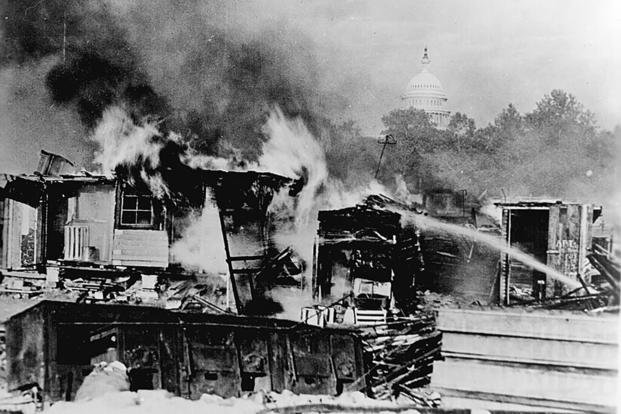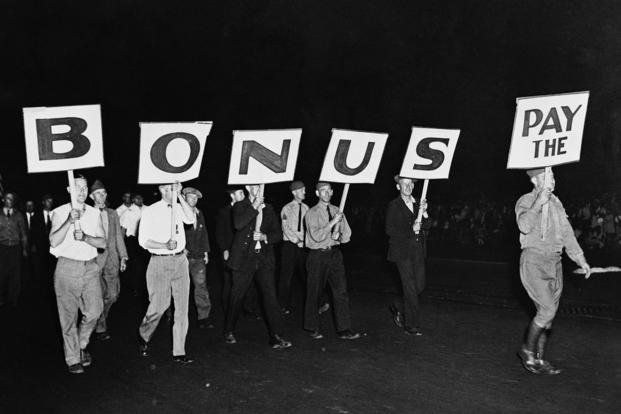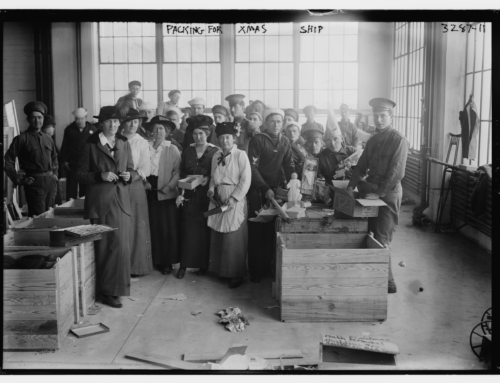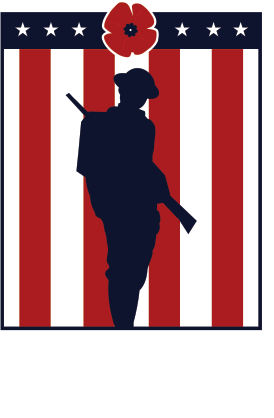That Time the Army Gassed WWI Veterans Protesting for Benefits
Published: 12 June 2025
By Joanna Guldin
via the Military.com website

newbonusarmy
A Bonus Army encampment burns after the U.S. Army attacks World War I veterans protesting their treatment by the federal government. (U.S. Signal Corps Photo)
1932 was one of the worst years of the Great Depression in America. The unemployment rate ballooned to nearly 24%. Desperate people, pushed by economic and environmental disaster, took to the roads looking for work, food and shelter. For most Americans, there was no relief. For World War I veterans who were owed money from the federal government, they had one more option.
In 1924, WWI veterans won a one-time payment from Congress — up to $625 — for their service in the war. It might sound like a pittance, but when adjusted for inflation, that $625 would be worth around $16,000 today. The catch? It would only be paid out in 1945.
In May 1932, a group of veterans calling themselves the Bonus Expeditionary Forces decided that wasn’t soon enough and made its way to Washington, D.C., to demand immediate payment. Dubbed the “Bonus Army” by the press, their ranks quickly swelled to nearly 20,000 (although some estimates suggest up to 40,000) as more veterans and their families — unemployed, hungry and angry at their treatment — set up camps along the Anacostia River and squatted in vacant federal buildings.

The ‘Pay the Bonus’ sign carried by this group of World War I veterans was typical of the banners throughout the demonstration in Washington, June 7, 1932. (AP Photo)
By most accounts, the camps — three in total — were generally peaceful and run well, despite being encampments made from cardboard and crates. The D.C. police superintendent was sympathetic toward the Bonus Army, providing blankets, securing transportation out of D.C. and even lobbying Congress for $75,000 to feed the group. Veterans gained permission to occupy at least some of the unused federal buildings in which they squatted. The racially integrated shantytowns were organized, requiring documentation of veteran status to squat in the area and included amenities such as a religious tent, a lending library and even a makeshift post office.
The veterans waited for a vote on a bill that would expedite their bonuses. In June 1932, the bill — worth $32 billion today — passed the House. In the Senate, John “Elmer” Thomas excoriated the chamber for its indifference, saying, “My fellow senators, are you proud of the record that has been made? … Billions for big business, but not a sou [French coin] for soldiers!” After the Senate defeat, the majority of protesters left Washington but thousands still remained, likely because they had nowhere else to go.
On July 28, things came to a head. D.C. officials, under pressure from President Herbert Hoover, ordered the city police to begin evicting remaining members of the Bonus Army. Two veterans were shot by police and died during an eviction — with both sides saying the other started the violence. Local leaders requested federal help, recognizing an eviction of several thousand desperate people would take more manpower than they had.
Enter three of the most venerated 20th-century Army legends.
→ Read the entire article on the Military.com website.
External Web Site Notice: This page contains information directly presented from an external source. The terms and conditions of this page may not be the same as those of this website. Click here to read the full disclaimer notice for external web sites. Thank you.



